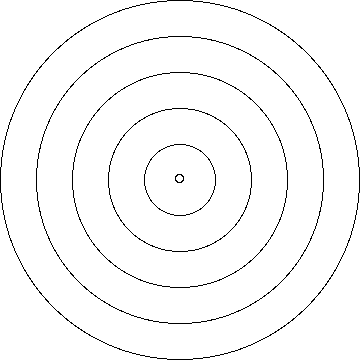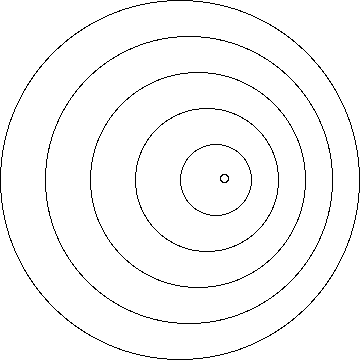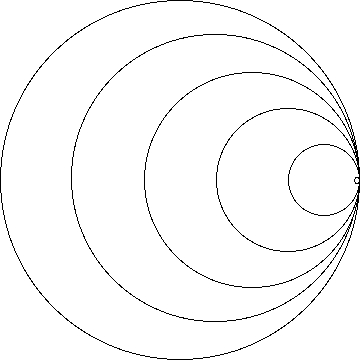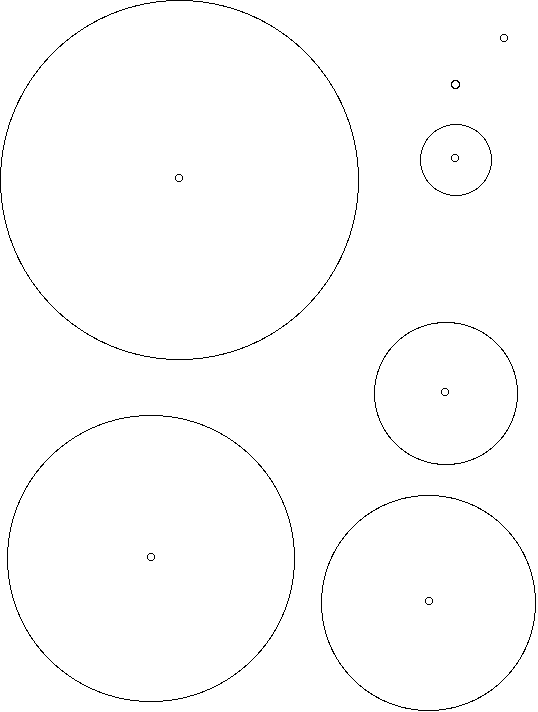
Introduction
Make a model of the sound coming from a moving source.
Material
Assembly
Print out the pattern of circles on this page: Pattern
On one sheet of transparency material use the permanent marker to trace all of the circles in the pattern. Remember to mark the dot at the center of each circle.
Optional: If you have a copier and the special transparency material that it requires (You will kill the copier if you use the wrong transparency material.) then you can print out the pattern directly onto the transparency.
Cut out the circles.
To Do and Notice
Stationary source

Place the sheet with the largest circle onto a white sheet of paper, then place the next smaller circle above it, and so on.
Line up all five of the circles over each other so that their centers all coincide.
This is the pattern of sound waves spreading from a stationary source.
Measure the wavelength of this sound, L.(i.e. the radial distance between adjacent circles.)
I measure L =1 cm.
This is a still photograph of a sound wave, if we assume that the circles are moving outward at 350 m/s what would be the frequency of this sound wave? use v = Lf.
Moving Source
In the middle of a piece of white paper make a row of dots in s straight line. The dots should be spaced L/2 apart.
Place the center of the largest circle on the lefthandmost dot. Slide the next smallest circle to the right by 1/2 a wavelength L/2, and place it over the next dot. then the next smaller one twice this much, L, and so on until the smallest circle has been moved 5 times as far, 5L/2.
You will have a pattern that looks like this

Measure the wavelength in front of the moving source and behind.
Compare it to the wavelength of the original signal from the source at rest, L.
I measure the wavelength in front of the moving source to be L = 0.5.
And I measure the wavelength behind to be L = 1.5 cm.
What is the frequency of the sound in front of the moving source and behind?
What's Going On?
The equation relating the wavelength of sound, L,
to its frequency, f, and the speed of sound V is V = Lf
For example a 1000 Hz source in air with a speed of sound V = 350 m/s
has a wavelength of 0.35 m.
A sound source with a frequency, f, emits sound
waves with a period T = 1/f.
For example a 1000 Hz sound source emits waves every T = 0.001
second.
The wavelength from the moving source is L = L0(1+-v/Vs)
Where L0 is the wavelength of the source at rest.
The frequency is F0 /(1-+v/Vs)
For more detail son the derivation and use of these equations see the Doppler Math Root.
Going Further
Play around with different spacings what happens if each dot is placed 1 wavelength apart? How about 2 wavelengths?

When the source moves 1 wavelength during each
period, each compression wave is emitted right on top of the previous
one this creates a shock wave, The source is moving at mach1, the
speed of sound.
The pattern

|
Scientific Explorations with Paul Doherty |
|
30 Oct 2006 |